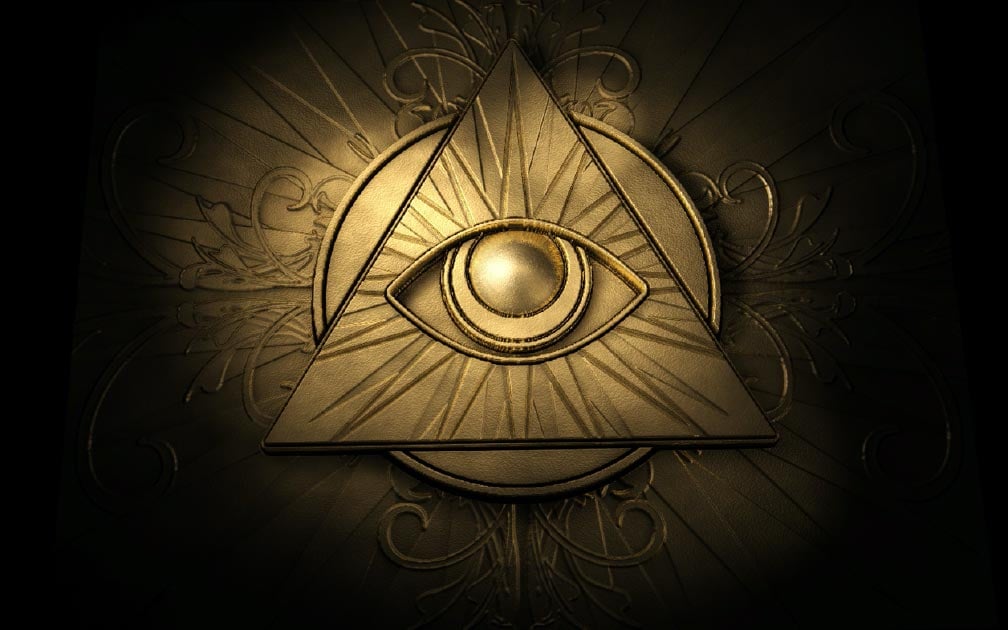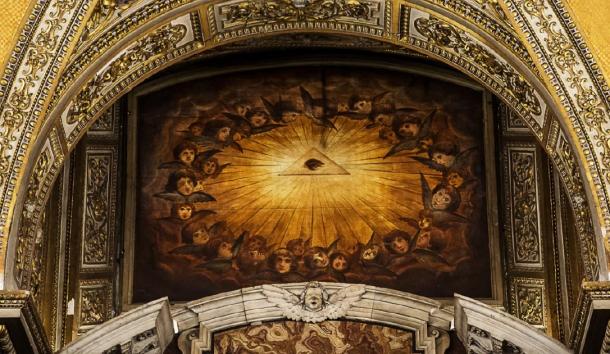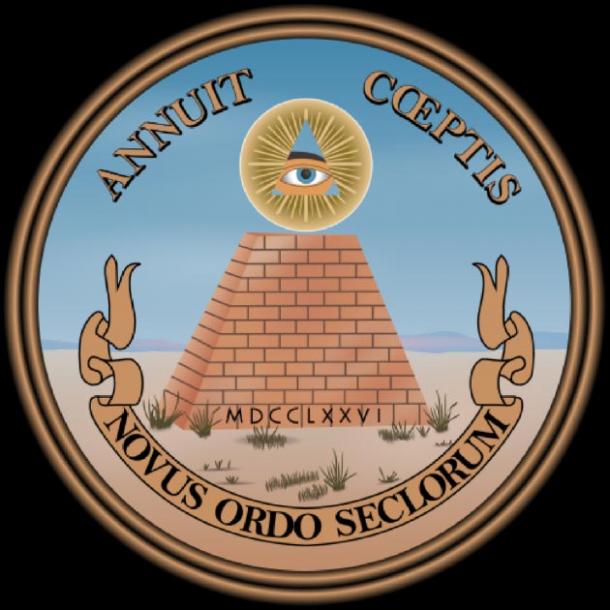
...............................................................................................................................................................
The All-Seeing Eye Of Providence
Wu
Mingren
The Eye of Providence
(known also as the all-seeing eye of God) is a well-known and popular symbol.
This symbol has been
used for centuries in both religious and secular contexts, and therefore its
representation can be found in many places.
For Americans, The
Eye of Providence is most commonly found on the reverse of the United States
one-dollar bill.
This design is in
turn derived from the reverse of the Great Seal of the United States.
The Eye of Providence
has also been associated with the Freemasons, and thanks to films, such as the
2004 National Treasure, starring Nicolas Cage, conspiracy theories linking the
Freemasons with the founding of the United States have been popularized.
The Eye of Providence
is commonly depicted as a single, realistic-looking eye within one or more
additional elements: a triangle, a burst of light, clouds, or all three.
The earliest-known
depiction of this symbol dates to the Renaissance. Nevertheless, eyes have had
a strong symbolic meaning in many cultures over the course of history.
The Ancient Egyptian
Eyes
One of the most
famous of these symbols is the Eye of Horus (known also as Wadjet, which means
‘Whole One’), which was immensely popular amongst the ancient Egyptians.
According to ancient
Egyptian mythology, Horus lost his left eye during a battle with his uncle
Seth.
This eye was
magically restored by the goddess Hathor, who is believed to have been either
Horus’ mother or wife. Thus, the Eye of Horus became a symbol of healing.
In another myth,
Horus presented his eye to his father, Osiris, to help him rule the Underworld.
Osiris ate the eye,
and he was restored to life. Thus, in this myth, the eye became a symbol of
life and resurrection.
These myths served to
popularize the Eye of Horus as a protective symbol, and therefore it was
commonly made into protective amulets. Such amulets continue to be popular even
today.
The ancient Egyptians
had another symbol similar to the Eye of Horus, which is known as the Eye of
Ra.
Unlike the Eye of
Horus, this was an aggressive symbol that focused on the destructive aspect of
the god Ra.
In one of the ancient
Egyptian myths, Ra was becoming old and weak, which caused people to disrespect
him.
Ra was furious that
they no longer stuck to laws, and that they were making jokes at his expense.
Therefore, he decided to punish mankind by sending the ‘Eye of Ra’ to destroy
them.
The Eye of Ra was a
goddess (different goddesses, including Hathor, Sekhmet, and Bast, are said to
possess this title) sent to earth in the form of a lion, and she immediately
began her slaughter of humanity.
Seeing the scale of
the destruction wrought by the goddess, Ra regretted his action, and called his
daughter to stop.
The goddess, however,
was in a bloodlust, and paid no heed to her father’s pleas.
Ra, fearing that all
of humanity would be wiped out if the goddess was allowed to continue on her
rampage, devised a cunning plan.
The god had 7000 jugs
of beer mixed with pomegranate juice, which made the beer red, and he poured
them in the fields around the Eye of Ra.
As the goddess drank
the ‘blood’, she became so drunk that she fell asleep, and only woke up three
days later with a terrible hangover. By this means, humanity was saved by Ra.
The Beginnings of the
Eye of Providence
Like the ancient
Egyptian Eye of Horus and Eye of Ra, the Eye of Providence is also associated
with the divine.
As mentioned already,
the earliest-known representation of the Eye of Providence is from the
Renaissance.
This representation
is found in a 1525 painting called the Supper at Emmaus by the Italian painter
Jacopo Pontormo.
The subject matter of
this painting is the second half of the ‘Road to Emmaus Appearance’ story found
towards the end of the Gospel according to Luke.
In this story, which
happens after Christ’s resurrection, Jesus appears to two of his disciples who
were on their way to a town called Emmaus.
After reaching the
town, Jesus stays with the two men to have supper with them, and this is the
scene painted by Pontormo.
This painting was
made for the Carthusians (a Catholic religious order known also as the Order of
St Bruno) of the Certosa del Galluzzo, in the suburbs of Florence.
Interestingly, a few
of the monks were painted by Pontormo behind Christ, who is shown blessing the
bread.
Above the head of
Christ is the Eye of Providence, which is meant to show that God was watching
the entire event.
The depiction of the
Eye of Providence on Pontormo’s Supper at Emmaus shows that it started off as a
Christian symbol.
Within this context,
the word ‘providence’ refers to ‘divine guidance’, specifically to that
provided by the God of Christianity.
Thus, in a way, the
Eye of Providence is meant to represent a form of spiritual guidance that pious
Christians ought to follow.
The Eye of Providence
may also be meant to represent the omnipresence, omnipotence, and omniscience
of God.
In addition, the
elements surrounding the eye take on a Christian meaning as well. For instance,
the triangle is a clear reference to the Holy Trinity – God the Father, God the
Son, and God the Holy Spirit.
The burst of light
and clouds are meant to symbolize divinity, holiness and God himself.
As a matter of fact,
these elements are also sometimes used when God is depicted in works of art,
for instance, when He is represented by the tetragrammaton, i.e. the name of
God in Hebrew transliterated in the four letters, YHWH.
Such depictions may
be found on stained glass windows in Christin churches, like the abbey church
of Saint-Germain-des-Prés, in Paris, where the Merovingian kings of Neustria
were buried.
Freemasonry and
Conspiracy Theories
In time, the Eye of
Providence was adopted by the Freemasons, who drew inspiration from the use of
human organs to represent abstract concepts by ancient cultures.
Thus, the open eye
was meant to symbolize watchfulness, and the Eye of Providence, being the eye
of the Supreme Being (since by this time many no longer believed in the
Christian God, but some other kind of divine or higher power out there).
This was meant to
represent the watchfulness and care of the divine for the universe.
In addition, this
symbol was meant to remind the Freemasons to maintain their standards of
morality, as they are being watched over by a higher force.
Furthermore, the Eye
of Providence may be regarded as a sign of spiritual illumination and
revelation.
In some instances,
the Eye of Providence is placed within or above the square and compasses,
arguably the most recognizable symbol of the Freemasons.
One interpretation
states that the square represents morality or virtue, whereas the compass
represents boundaries or wisdom of conduct.
Another
interpretation of the symbol states that the square deals with matters
concerning the earth and the body, whilst the compass deals with those of the
heavens and the soul.
It may also be said
that since the points of the compass are placed below the square, it is meant
to signify that one is only dealing with the moral and political meanings of
the symbol, but not their deeper philosophical and spiritual ones.
Moreover, the
intersection of the compass and square may be understood as denoting the
intermingling between the divine and the human, and that there is a spiritual
dimension even in the most mundane aspects of life.
Numerous conspiracy
theories have linked the Freemasons with the founding of the United States
through the Eye of Providence.
This symbol is also
found on the reverse of the Great Seal of the United States.
The seal (both its
obverse and reverse) is also printed on the reverse of the United States
one-dollar bill, and the symbol is therefore, quite literally, in most
Americans’ pockets.
One common conspiracy
theory claims that the application of the Eye of Providence on the Great Seal
was a way for the Freemasons to project their watchful power over the country.
As already mentioned,
the Freemasons saw the Eye of Providence as a symbol of the Supreme Being,
rather than their own power, and that it was to remind them to uphold their
standards of morality.
Therefore, it is
unlikely that they would have used it as a symbol of their power.
A slight variation to
this conspiracy theory is that the American government is always watching its
people. Though this is certainly not the intention of the symbol, if one were
to return to its original meaning.
In this case, it is
meant to show that God is watching over America, and that the country was being
created under His watchful eye.
The phrase ‘In God We
Trust’ on the reverse of the one-dollar bill is further evidence of the
symbol’s association with God, rather than with the American government.
The Great Seal
The Eye of Providence
on the Great Seal of the United States is surrounded by a triangle and a burst
of light (like the ones used in Christian art), and it is placed on the top of
an unfinished pyramid.
The
design of the seal was finalized in 1782, and the description of the reverse,
as found in Charles Thomson’s (who was the Secretary of Congress) “Remarks and
Explanation,” adopted by the Continental Congress (June 20, 1782) is “Reverse.
The pyramid signifies Strength and Duration: The Eye over it & the Motto
allude to the many signal interpositions of providence in favor of the American
cause. The date underneath is that of the Declaration of Independence and the
words under it signify the beginning of the New American Era, which commences
from that date.”
Interestingly, whilst
drawings of the obverse were made as soon as the design was adopted, the first
drawing of the reverse was only made four years later, in 1786.
This was drawn by
James Trenchard, an engraver from Philadelphia, for the October 1786 issue of
the Columbian Magazine .
The second drawing of
the reverse that we know of was made by Benson L. Lossing, an artist and
historian, in 1856.
The drawing was meant
to accompany an article he had written on the Great Seal for the July 1856
issue of Harper’s New Monthly Magazine.
Lossing made some
changes to Trenchard’s design, and this second drawing has influenced all later
realizations of Thomson’s written description of 1782 (including the one on the
reverse of the one-dollar bill, which follows almost exactly Lossing’s design).
This is except for
the Great Seal Centennial Medal that was struck in 1882.
The reverse of the
medal followed Trenchard’s design closely, and it was the first realization of
the seal’s reverse to be issued officially by the American government.
Incidentally, the
Continental Congress was provided with a design for the Great Seal’s reverse,
in case it wanted to impress the back surfaces of wax pendant seals, which it
had been using for treaties between 1815 and 1871.
The back surfaces,
however, were never impressed, and enthusiasm for cutting a die of the reverse
gradually diminished. Therefore, not one reverse die has been cut till this
day.
Trenchard’s design of
the Great Seal places the Eye of Providence atop an unfinished pyramid with 13
steps.
This number is
symbolic, as it represents the 13 original British colonies that formed the
United States.
The two mottos
mentioned in Thomson’s description are in Latin, and are as follows, Annuit
Coeptis (meaning ‘He [God] has favored our undertakings’, and Novus Ordo
Seclorum (meaning ‘a new order of the ages’).
The former is placed
over the Eye of Providence, whilst the latter under the pyramid. The year of
the Declaration of Independence, in the Roman numerals MDCCLXXVI (1776), is
found on the bottom step of the pyramid.
One of the changes
made by Lossing to Trenchard’s design was to replace the right Eye of
Providence with a left one, and this has remained ever since.
In addition,
Lossing’s pyramid, which is rather square, as opposed to Trenchard’s elongated
one, is given a deep perspective, and the ground around it is filled with
flowers and grass.
By Wu
Mingren
I am a
university student doing a BA degree in Archaeology. My interests range from
‘conventional’ to ‘radical’ interpretations of the
archaeological/textual/pictorial data set. I believe that intellectual
engagement by advocates from both ends of the spectrum would serve to enhance
our understanding of the past. In addition, such discussions would serve to
bring Archaeology to a wider audience as well as to stimulate their interest,
curiosity, and critical thinking of such issues.

The ancient
Egyptian Eye of Horus.
Jacopo
Pontormo’s Supper at Emmaus, where the Eye of Providence is seen above Christ.
The Eye of
Providence shown on the wall of a Church.
The freemason
/ Eye of Providence symbol with the square and compass.
The Eye of
Providence shown on the left side of the United States one-dollar bill.
Reverse of the Great Seal of the United States
with the Eye of Providence shown at the top







No comments:
Post a Comment